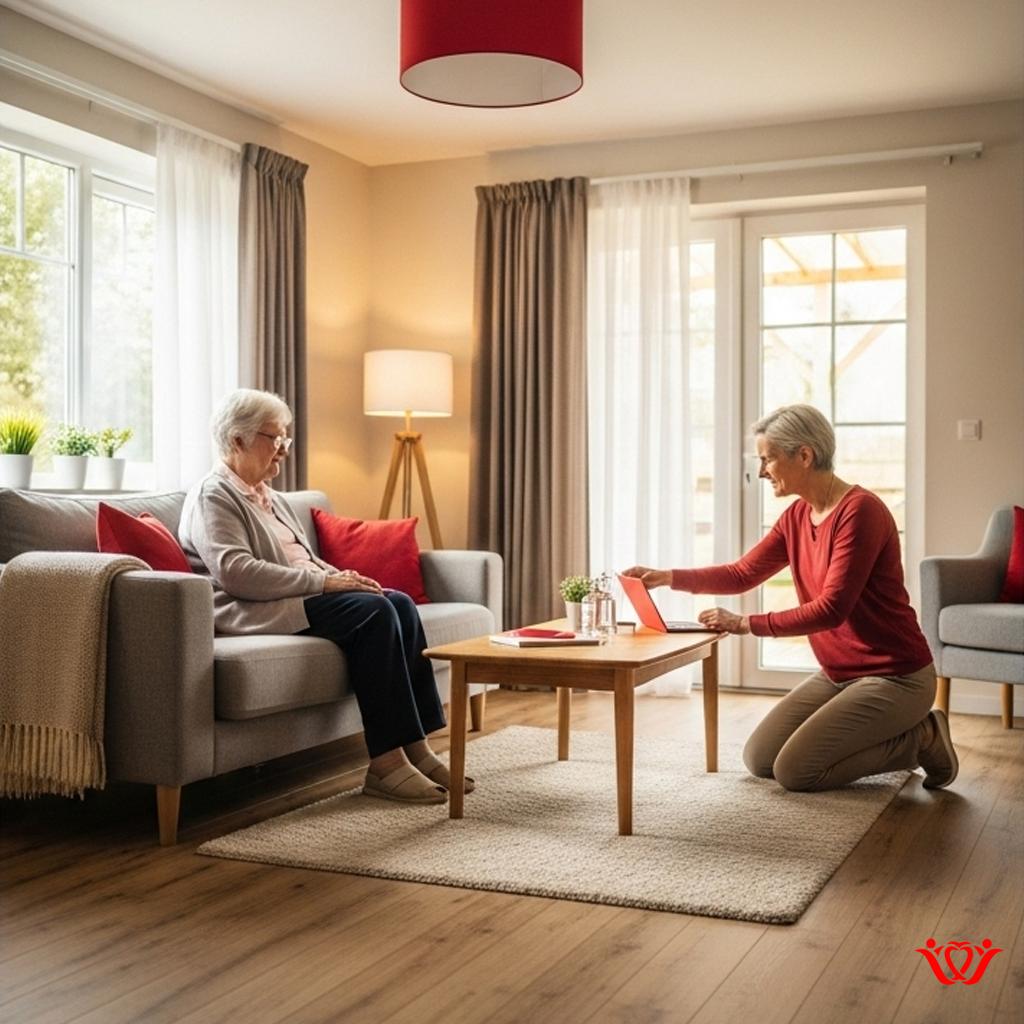Safely Care for Dementia at Home: Your Home Environment Guide

Creating a Dementia-Friendly Sanctuary in Your New Jersey Home
Living with dementia presents unique challenges, not only for the individual but also for their families and caregivers. In New Jersey, as elsewhere, many families express a strong desire for their loved ones to remain in the comfort and familiarity of their own homes for as long as possible. This preference is understandable; a familiar environment can provide a sense of security and reduce confusion often associated with new surroundings.
However, an ordinary home environment may inadvertently pose risks or create unnecessary difficulties for someone with dementia. Simple features like patterned carpets, dim lighting, or easily accessible hazardous items can become significant obstacles. This guide is designed to help New Jersey families and caregivers transform a standard home into a safe, supportive, and empowering space for individuals living with dementia, promoting independence and enhancing quality of life.
Understanding the Impact of Environment on Dementia Care
The physical environment plays a profound role in the well-being and daily functioning of an individual with dementia. Their ability to interpret surroundings, process information, and respond appropriately is often impaired, making even minor environmental inconsistencies potentially distressing or dangerous. A well-designed home environment can:
- Reduce confusion and disorientation: Clear pathways, consistent layouts, and simple decor help individuals navigate with less stress.
- Prevent accidents and injuries: Addressing common hazards like falls, burns, and unsupervised access to dangerous items is paramount. In New Jersey, fall prevention is a key focus for senior health initiatives, recognizing the significant impact falls have on quality of life and healthcare costs.
- Minimize agitation and anxiety: A calm, predictable, and uncluttered space can decrease sensory overload and promote a sense of peace.
- Promote independence and dignity: When the environment supports daily tasks, individuals can retain more control over their lives.
- Facilitate engagement and cognitive stimulation: Purposeful design can encourage participation in activities and recall of memories.
Conversely, an unsuitable environment can exacerbate symptoms, leading to increased agitation, confusion, wandering, and a higher risk of injury. Prioritizing environmental modifications is an investment in safety, comfort, and peace of mind.
Key Principles for a Dementia-Safe Home in New Jersey
Creating a dementia-friendly home involves applying several core principles. These are not merely about removing dangers, but about proactively designing a space that nurtures and supports the individual.
Simplicity and Clarity: Declutter and Streamline
A cluttered environment can be overwhelming and disorienting for someone with dementia. Too many objects, patterns, or choices can lead to confusion and agitation. The goal is to create a sense of calm and order.
- Declutter ruthlessly: Remove unnecessary furniture, ornaments, and items from surfaces. Less is more.
- Reduce visual noise: Opt for plain walls and solid-colored fabrics over busy patterns. Intricate patterns on carpets or wallpaper can be misinterpreted as obstacles or holes.
- Ensure clear pathways: All walking areas should be free from obstructions, loose rugs, or trailing cords.
- Use consistent lighting: Maintain consistent, glare-free illumination throughout the home to reduce shadows and improve visibility.
Safety First: Proactive Hazard Prevention
Safety is the cornerstone of a dementia-friendly home. Individuals with dementia may not recognize hazards, making it essential to eliminate potential dangers before they become an issue. New Jersey families understand the importance of home safety, especially for vulnerable populations.
- Fall prevention: This is perhaps the most critical aspect. Install grab bars in bathrooms, ensure adequate lighting, remove throw rugs, and secure all electrical cords. Consider non-slip flooring or mats where appropriate.
- Medication management: Keep all medications locked away and out of sight. A locked cabinet or a medication dispenser with an alarm can be invaluable.
- Kitchen safety: Unplug small appliances when not in use, remove stove knobs, or install safety covers. Lock away sharp utensils, cleaning supplies, and breakable items.
- Access to hazards: Securely lock away hazardous chemicals (cleaning supplies, paint), tools, and anything that could be ingested or misused.
- Fire safety: Ensure smoke detectors and carbon monoxide detectors are functioning and tested regularly. Have a clear escape plan and review it with all caregivers. The New Jersey Department of Community Affairs provides excellent resources on residential fire safety.
Promoting Independence and Comfort: Personalization and Accessibility
While safety is paramount, supporting dignity and independence is equally important. An enabling environment allows the individual to participate in daily activities for as long as possible.
- Personalize the space: Incorporate familiar objects, photos, and cherished belongings that evoke positive memories. This can provide comfort and a sense of identity.
- Accessibility: Ensure common items are within easy reach. Use lever-style door handles if grip is an issue. Consider elevated toilet seats and shower chairs.
- Comfortable furnishings: Choose furniture that is stable, comfortable, and easy to get in and out of. Avoid furniture with sharp edges.
Stimulating Engagement (Without Overwhelm): Activities and Memory Cues
A dementia-friendly home isn’t sterile; it’s a place that gently encourages engagement and cognitive function without causing undue stress.
- Meaningful activities: Create dedicated spaces or baskets with familiar activities the individual enjoys, such as photo albums, simple puzzles, craft supplies, or music.
- Memory cues: Label drawers and cabinets with pictures or words to help locate items. Use large-print clocks and calendars.
- Sensory stimulation: Incorporate elements that engage the senses positively, such as soft blankets, calming music, or pleasant aromas.
Room-by-Room Home Environment Adjustments
Let’s delve into specific modifications for each area of the home, tailored to common challenges faced by individuals with dementia.
The Living Room: A Hub for Comfort and Engagement
The living room is often the central gathering place. It should be inviting, calming, and easy to navigate.
- Furniture arrangement: Arrange furniture to create clear pathways. Avoid placing furniture in the middle of the room where it could be a tripping hazard.
- Lighting: Ensure even, bright, glare-free lighting. Use floor lamps or table lamps to supplement overhead lighting, reducing shadows.
- Familiar objects: Display cherished photographs, meaningful artwork, or familiar items that can spark conversation and positive memories.
- Television and electronics: Position the television for comfortable viewing, but consider its placement to avoid overstimulation if the individual becomes agitated by background noise or fast-moving images. Simplify remote controls if possible.
The Kitchen: Navigating a High-Risk Area
The kitchen, with its appliances, sharp objects, and heat, can be one of the most dangerous rooms. Safety modifications here are critical.
- Appliance safety: Install knob covers on stove burners or remove knobs when not in use. Consider an automatic shut-off device for the stove. Unplug toaster ovens, coffee makers, and other small appliances after use.
- Sharp objects and chemicals: Lock away knives, scissors, and other sharp utensils. Store all cleaning supplies, detergents, and hazardous chemicals in a locked cabinet.
- Food storage: Clearly label food items, especially in the refrigerator and pantry, to aid recognition and reduce confusion. Dispose of expired food promptly.
- Supervision: Constant or consistent supervision may be necessary during meal preparation to ensure safety and prevent accidents.
The Bedroom: A Haven for Rest and Security
The bedroom should be a calming space that promotes restful sleep and a sense of security.
- Bed height: Ensure the bed is at a comfortable height for getting in and out, or consider a bed rail for support if appropriate and safe.
- Nightlights: Place nightlights along the path to the bathroom and in the bedroom to prevent falls during nighttime awakenings.
- Clear paths: Keep the path from the bed to the bathroom completely clear of clutter.
- Comfortable textiles: Use soft, comfortable bedding and blankets. Avoid busy patterns.
- Minimizing clutter: Keep surfaces clear of unnecessary items to reduce visual confusion and potential tripping hazards.
The Bathroom: Prioritizing Safety and Privacy
The bathroom is another high-risk area due to wet surfaces and hard fixtures.
- Grab bars: Install grab bars next to the toilet and inside the shower/tub. Ensure they are professionally installed and secured into wall studs.
- Non-slip mats: Use non-slip mats or strips in the shower/tub and on the bathroom floor.
- Elevated toilet seat: A raised toilet seat can make sitting and standing easier and safer.
- Hot water temperature: Set the water heater thermostat to no higher than 120°F (49°C) to prevent scalding.
- Clear organization: Keep only essential toiletries readily accessible. Lock away medications and hazardous cleaning products.
- Visual cues: Use contrasting colors for toilet seats or grab bars to make them more visible.
Hallways and Stairwells: Ensuring Clear Passage
These transitional spaces are often overlooked but can pose significant fall risks.
- Lighting: Ensure hallways are brightly and evenly lit, day and night. Use motion-sensor lights if helpful.
- Handrails: Install sturdy handrails on both sides of stairwells, extending beyond the first and last steps.
- Remove tripping hazards: Eliminate throw rugs, loose cords, or decorative items from hallways and stairwells.
- Visual cues: If stairs are a particular challenge, consider contrasting colored tape on the edges of steps to enhance visibility.
Outdoor Spaces: Safe Exploration and Enjoyment
Outdoor areas can provide therapeutic benefits, but they also require careful consideration for safety.
- Securing boundaries: If wandering is a concern, ensure fences or gates are secure and difficult to open independently. Consider installing door alarms.
- Accessible pathways: Ensure garden paths are level, non-slip, and free from obstacles.
- Sensory garden elements: Incorporate plants with pleasant scents, varied textures, and vibrant colors to provide safe sensory stimulation.
- Seating: Provide comfortable, stable outdoor seating in shaded areas.
Addressing Specific Dementia-Related Behaviors Through Environment
Environmental modifications can be particularly effective in managing challenging behaviors often associated with dementia.
Wandering: Creating Safe Boundaries and Distractions
Wandering is a common concern. While environmental changes can help, it’s crucial to understand the reasons behind it (e.g., searching for something, boredom, confusion).
- Door alarms: Install alarms on exterior doors that chime when opened.
- Secure locks: Use locks that are difficult for the individual to manipulate (e.g., slide bolts placed high or low), or key-operated locks. Avoid deadbolts that could trap someone inside during an emergency.
- Visual deterrents: Consider placing a dark mat in front of an exit door (it may appear as a hole) or a ‘stop’ sign.
- Safe outdoor access: If possible, create a secure outdoor area where the individual can wander safely without risk of getting lost.
Agitation and Confusion: Promoting Calm and Clarity
Environmental factors can significantly contribute to agitation. Reducing stressors is key.
- Reduce noise: Minimize background noise from televisions, radios, or busy street sounds. Create quiet zones.
- Calming colors: Use soft, neutral colors for walls and furnishings. Avoid bright, jarring colors or busy patterns.
- Familiar objects: Surround the individual with familiar and comforting items.
- Consistent routines: While not a physical environmental change, a consistent daily routine creates a predictable ‘temporal environment’ that reduces anxiety.
Sleep Disturbances: Optimizing the Sleep Environment
Sleep problems are common. The bedroom environment can either hinder or help restful sleep.
- Darkness and quiet: Ensure the bedroom is dark and quiet at night. Use blackout curtains.
- Comfortable temperature: Maintain a comfortable, consistent temperature.
- Daylight exposure: Maximize natural light exposure during the day to help regulate the sleep-wake cycle. Encourage outdoor time in New Jersey’s beautiful parks when weather permits.
Technology’s Role in Enhancing Home Safety for Dementia Care
Modern technology offers valuable tools to supplement environmental modifications and support safe independent living.
- Smart home devices: Smart lighting systems can be programmed to adjust throughout the day, mimicking natural light patterns. Smart thermostats can maintain a comfortable temperature.
- Medical alert systems: Wearable devices with fall detection and emergency call buttons provide immediate assistance in an emergency. Many New Jersey seniors utilize these systems for peace of mind.
- Monitoring devices: Discreet sensors can monitor door openings, bed exits, or appliance use, alerting caregivers to potential issues.
- GPS trackers: For individuals prone to wandering, GPS devices (worn on the person or integrated into shoes) can help locate them quickly if they leave the home.
- Memory aids: Digital photo frames, voice-activated assistants, or specialized apps can help with reminders and social engagement.
It’s important to introduce technology gradually and ensure the individual is comfortable with it to avoid causing further confusion.
The Importance of Professional Support: WeCare Home Caregivers in New Jersey
While environmental modifications are essential, they are often most effective when combined with professional care and support. WeCare Home Caregivers understands the unique needs of New Jersey families navigating dementia care at home.
- Personalized Care Plans: Our experienced caregivers can assist with daily routines, personal care, medication reminders, and engaging activities tailored to the individual’s needs and preferences. This allows families to implement environmental changes while ensuring consistent, compassionate support.
- Caregiver Respite: Modifying a home and providing constant supervision can be exhausting. Our services offer respite for family caregivers, allowing them to rest and recharge, knowing their loved one is in capable hands.
- Expert Guidance: Our team can offer insights and practical advice on further environmental adjustments, drawing on their experience in dementia care. They can help implement routines that complement the home’s design.
- Monitoring and Reporting: Professional caregivers provide valuable observations regarding the individual’s response to the environment, enabling ongoing adjustments to maximize comfort and safety.
For adult children in places like Bergen County, Essex County, or Monmouth County, researching options for aging parents, partnering with a local agency like WeCare Home Caregivers means gaining a team dedicated to their parent’s well-being. For caregivers of individuals with disabilities who also experience cognitive decline, our services provide specialized assistance to maintain a stable and supportive home life.
Ongoing Assessment and Adaptation
Dementia is a progressive condition, and an individual’s needs will change over time. What works today may need adjustment in six months or a year. Therefore, it is important to:
- Regularly assess the environment: Periodically walk through the home with fresh eyes, looking for new hazards or areas of difficulty.
- Observe the individual: Pay attention to how they interact with their surroundings. Do they struggle in certain areas? Do they seem agitated by specific stimuli?
- Be flexible and adaptable: Be prepared to make ongoing changes as cognitive abilities shift.
Conclusion: A Safer, More Supportive Home Awaits
Creating a safe and supportive home environment is a cornerstone of effective dementia care. It is a tangible way to enhance the quality of life for your loved one, reduce risks, and promote a sense of calm and independence. While the task may seem daunting, starting with small, manageable changes can make a significant difference.
For families and caregivers across New Jersey, remember that you don’t have to navigate this journey alone. WeCare Home Caregivers is here to provide the compassionate, professional in-home support that complements your efforts in creating an optimal living space. Together, we can ensure your loved one can continue to live safely and comfortably in the familiar surroundings of their own home, enjoying dignity and peace of mind.
For more information on dementia resources in New Jersey, you may find the New Jersey Department of Human Services, Division of Aging Services, to be a valuable resource. Additionally, the Alzheimer’s Association Greater New Jersey Chapter offers extensive support and educational programs for families and caregivers throughout the state.



